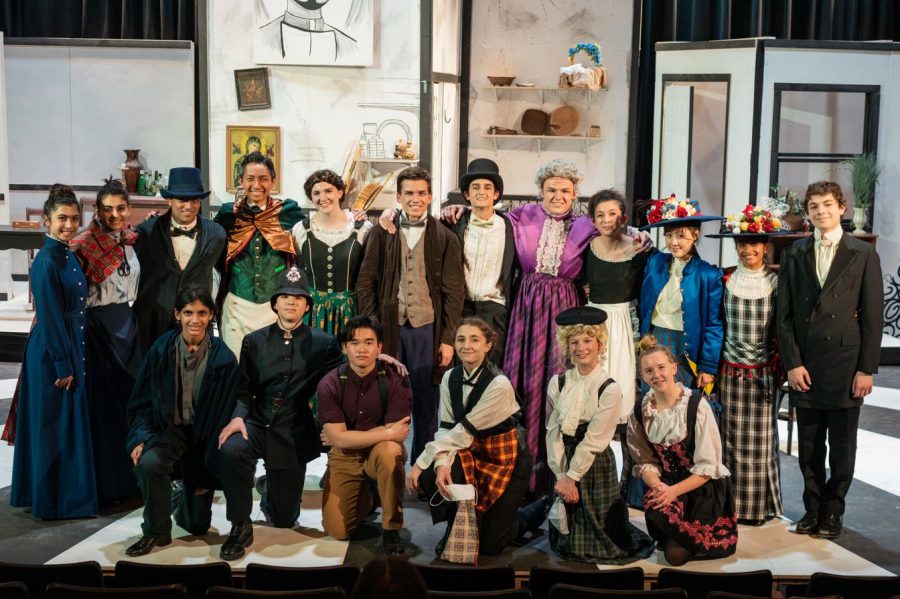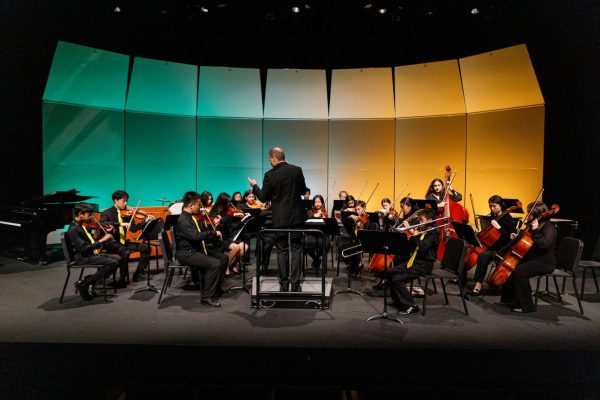To Mask or Not To Mask
… that is the question Performing Arts students are asking themselves now that mask mandates have been lifted
The cast of On The Razzle, the Bishop’s spring play, pose without masks. On The Razzle was the first performance to allow students to be maskless onstage.
When the 2021 Bishop’s fall play, On The Razzle, opened on March 17, people were just happy to be back in the theater. Friends and family were finally able to enjoy performing arts as they would have before the pandemic… or, almost as they would have before the pandemic, as masks were still required for the audience, cast, and crew. But since mask mandates were lifted as of March 12, students involved in performing arts face a choice about whether to continue wearing them or not. So how do they feel about masks in performing arts?
“It… has been interesting,” shared Bella Combs (‘25) when asked about her experience deciding whether or not to wear a mask in the spring play. She went on to explain that it was difficult to evaluate people’s comfort levels when there are so many different factors coming into play, like the actors’ locations. “Backstage is a smaller space, and there are people that aren’t comfortable with it, but onstage, it’s an open space,” she clarified.
There’s also the question of peer pressure: what others are doing has an impact on individual students’ decisions, even more so since, according to Bella, “Some people are of the opinion that the cast has to look uniform… [and] the question of how it looks onstage is definitely an aspect.”
But Elizabeth Jin (‘24), another student in theatre, also acknowledges that “the audience understands it’s not real. There’s a level of suspension of disbelief for the audience,” which makes it less important that the entire cast is wearing the same thing. By her logic, if the people watching theatre can make due with watching set changes and flubbed lines, what should stop them from applying the same principles to masks? “Now, if it were film, that would be more of a problem,” she says, considering that movies are meant to create a world in which there is no need for the audience to rationalize.
Another argument in favor of masks is that they have actually helped actors such as Mira Singh (‘25), also in the spring play, who thinks that masks have taught performers how to “express emotion without using the bottom half of your face” and given them “the ability to enhance their performances.” Acting with a mask on has forced actors to work on enunciation and vocal inflection, as well as acting with gestures and movement rather than relying solely on facial expressions.
And although August Whitman (‘22) agrees that masks have aided some in practicing specific skills, he does believe that “workshopping acting skills is a lot different than performing for an audience” and that audiences would be “put off” by actors wearing masks.
But in some cases, it’s not a question of being in favor of masks or not, but simply of whether they actually work. Nirvana Shiwmangal (‘25), a saxophone player and member of Jazz Band, expressed that she is “all for wearing masks, but the usefulness of those masks just isn’t great.” The masks that are used in Jazz Band have openings, which, although they allow students to play instruments, offer little protection. And even if you use a bell cover (“a hairnet for your instrument,” as Nirvana put it), air can still escape through the keys.
For some, these masks aren’t just ineffective and unsafe, but also uncomfortable. Steven Yin (‘24), another student in Jazz Band, expresses that “something that was noticeable to me, and made me feel somewhat uncomfortable, was that the mask made it harder to take a breath in between phrases (for a wind player like me).” He explained that the masks made it difficult to breathe during the fraction of a second before having to keep playing, and that the feeling was akin to having to run sprints while wearing a mask.
No matter what decision students arrive at, there are many pros and cons to be weighed, and there is no doubt that masks will continue to be a part of our day to day lives for the foreseeable future.

Lucy is a senior and Lead Content Editor for The Tower. This is her fourth year on the staff and second on the editorial team, and she can’t wait to...







